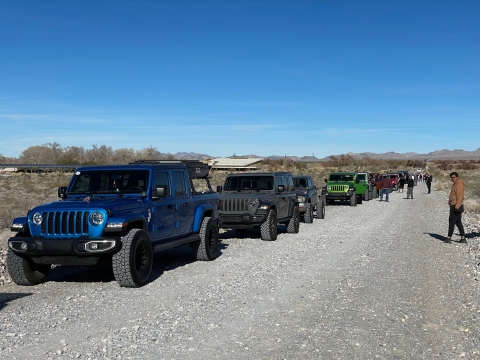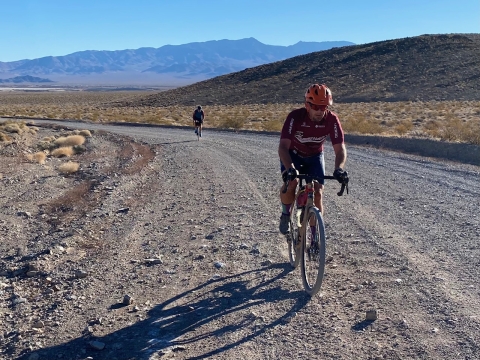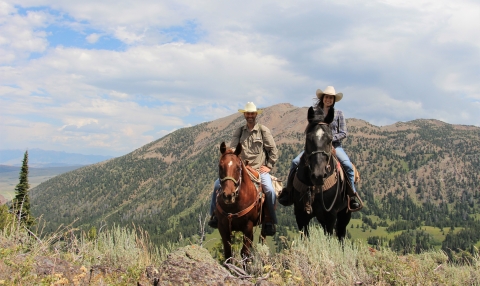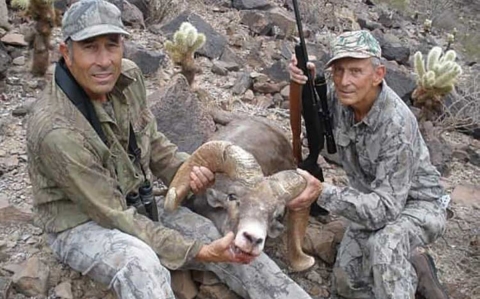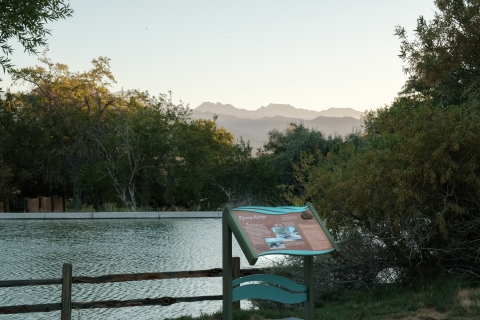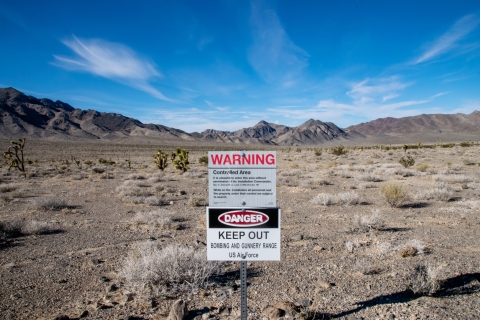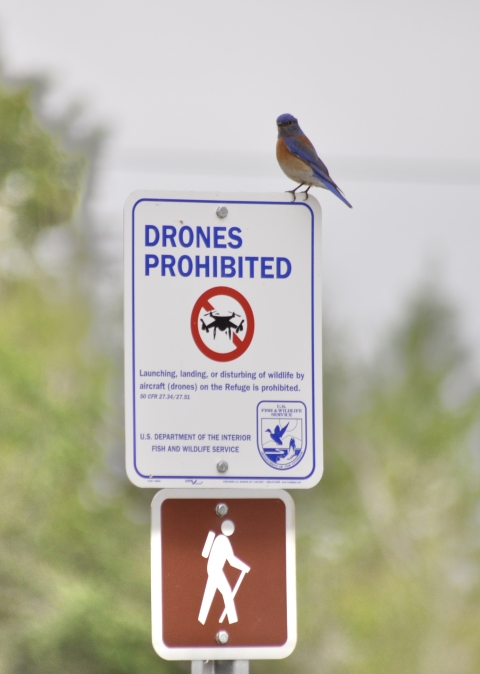Facility Rules and Policies
Know Before You Go
Visitors may enter the refuge between 4:00 a.m. and sunset. An automatic access gate was installed on Corn Creek Road in January 2023, and is now fully operational. The gate opens at approximately 4:00 a.m. and closes at sunset. Visitors can exit the refuge after sunset by slowly pulling up to the gate to activate the sensor and open the gate. The refuge remains open for backcountry camping; however visitors must enter the refuge between 4:00 a.m. and sunset. If those who are camping on the refuge leave and cannot return prior to sunset, they will be able to reenter the refuge at 4:00 the next morning. Emergency services are able to enter the refuge 24 hours a day.
If you are heading beyond Corn Creek, you need a high-clearance vehicle, and four-wheel drive (4WD) is suggested. Make sure your vehicle is ready for the trip - check your tires, fuel, fluids, and battery. The most common problem people experience is flat tires – a spare is a must!
Cell phone reception in the refuge is extremely limited. Don’t assume it will work! Make a safety plan before you go and always let someone know where you will be and when you plan to return.
Road conditions constantly change. Check current conditions ahead of time for updates, closures, or hazardous conditions.
Flash floods can happen quickly and during any time of year, particularly during the summer monsoons. A rainstorm miles away can cause a flash flood through a storm-free area. Keep to higher ground and avoid hiking and camping in washes and canyons. Flash floods are misleading in their depth and speed - never attempt to drive through or otherwise enter flood waters!
Weather here can be extreme. Temperatures may reach upward of 120°F (50°C) in the summer and can drop 50°F (10°C) in just 24 hours. Dress in layers and protect yourself from the sun.
Carry and drink at least one gallon (4 liters) of water per person per day. Water in springs and water developments (guzzlers) is for wildlife and emergency use only, with the exception of Wiregrass Spring near Hidden Forest Cabin. All water used must be purified prior to consumption.
Know your limits and be safe.
Refuge phone number: 702-879-6110
Non-emergency dispatch: 702-293-8998
Emergency dispatch: 702-293-8932
We want you and everyone to have a great time on your visit - please follow all Rules and Regulations.
We have several rules and regulations in place to help with the protection of our wildlife and their habitats, as well as for the enjoyment of all visitors to the refuge.
Please familiarize yourself with these before you come. We hope you enjoy your time at Desert NWR!
All organized group activities, including portrait and event photography – commercial or otherwise, as well as tours and organized group visits – require a special use permit. For more information or to obtain a permit, please contact Michael Matthews, Wildlife Refuge Manager, at michael_matthews@fws.gov or 702-879-6110.
Road conditions constantly change. Check current road conditions for updates, closures, or hazardous conditions. Road closed signs are posted for your safety.
Vehicle access to the refuge is only permitted on designated public access roads. This access is allowed to enable visitors to engage in priority wildlife-dependent public uses of the National Wildlife Refuge System. If you are going beyond Corn Creek, you need a high-clearance vehicle with good tires, and four-wheel drive (4WD) is suggested. Make sure your vehicle is ready for the trip - check your tires, fuel, fluids, and battery. The most common problem people experience is a flat tire – a spare, and the means to change it, are a must!
Only registered and insured passenger vehicles are allowed on the refuge. Passenger vehicle is defined as a "motor vehicle that is designed, constructed or adapted for the principal purpose of transporting passengers," but excludes off-highway vehicles. All off-highway vehicles (OHVs), are prohibited because of impacts to the land and natural and cultural resources. OHVs are defined as "a motor vehicle that is designed primarily for off-highway and all-terrain use." This definition includes, but is not limited to, side-by-sides, quads, dune buggies, four-wheelers.
Motorcycles must be registered, insured, and have rear view mirrors.
For nearby locations where OHV use is permitted, please visit the Nevada Off-Highway Vehicles Program.
The speed limit for all gravel public access roads is 25 miles per hour. Please protect wildlife and habitat - stay on designated roads and follow posted speed limits.
Bicycles are allowed on designated public access roads. Riding bicycles off road or on trails is prohibited.
Horseback riding and hiking can be enjoyed throughout the refuge, except on the trails behind the visitor center.
Please carry water and feed for your horse – water sources are limited and critical to our wildlife. To help keep non-native plants out of the refuge, certified weed-free feed is required.
Camping is allowed year-round on the refuge in designated areas.
Desert Pass campground is located on Mormon Well Road, 28 miles (45 km) from Corn Creek. The campground offers vault toilets and six primitive camping sites, each with a picnic table, fire ring, and tent pad. There is no water available at the campground – please make sure to bring all the water you will need. Campsites are fee-free and are on a first-come, first-served basis.
Car camping is permitted along designated public access roads in existing turnouts.
Backcountry camping is allowed throughout the refuge. All camping must be at least 100 yards away from water developments (guzzlers) or springs.
When conditions allow, campfires are permitted in established areas. You are required to bring all of your own firewood – the downed wood provides habitat for wildlife and returns nutrients to the soil. Cutting or collecting live or dead vegetation is prohibited Please note that campfires are prohibited in the backcountry, including the Hidden Forest Cabin. Backpacking stoves are allowed. Please check current fire restrictions that may be in place before your trip.
Camping is limited to 14 consecutive days during any 28-day period. Following the 14-day period, campers are required to leave the refuge until completion of the 28-day period.
Visitors may enter the refuge between 4:00 a.m. and sunset. An automatic access gate was installed on Corn Creek Road in January 2023, and is now fully operational. The gate opens at approximately 4:00 a.m. and closes at sunset. Visitors can exit the refuge after sunset by slowly pulling up to the gate to activate the sensor and open the gate. The refuge remains open for backcountry camping; however visitors must enter the refuge between 4:00 a.m. and sunset. If those who are camping on the refuge leave and cannot return prior to sunset, they will be able to reenter the refuge at 4:00 the next morning. Emergency services are able to enter the refuge 24 hours a day.
Firearms may be carried on the refuge following Nevada state regulations.
Firearms are not permitted inside the Visitor Center.
Limited desert bighorn sheep hunting is available by state-issued permit only. Hunting dove, chukar, and quail is permitted only within in the Sitting Dog Unit located in the northern part of the refuge during the state-designated hunt seasons. Please refer to the upland game bird hunting guide for more information. No other hunting is permitted on the refuge.
For your convenience, please refer to this hunting area map.
Firearms and weapons may only be discharged during legal hunting activities. Carrying or possessing other weapons including crossbows, bows and arrows, or air guns is prohibited. This includes carrying, possessing, or discharging fireworks and explosives. Target shooting is prohibited on any national wildlife refuge national wildlife refuge
A national wildlife refuge is typically a contiguous area of land and water managed by the U.S. Fish and Wildlife Service for the conservation and, where appropriate, restoration of fish, wildlife and plant resources and their habitats for the benefit of present and future generations of Americans.
Learn more about national wildlife refuge .
Trail camera use is prohibited.
For more information about hunting in Nevada or to obtain bighorn sheep tags, please visit the Nevada Department of Wildlife.
The refuge is located in the traditional homeland of Newe (Western Shoshone) and Nuwu/Nuwuvi (Southern Paiute/Chemehuevi) Tribes. All cultural and paleontological resources and sites on the refuge are protected. Please enjoy the petroglyphs, pictographs, fossils, and archeological sites throughout the refuge, but take only pictures.
Strive to visit just like an archaeologist. Don’t touch or remove any artifacts - it not only prevents future visitors from being able to enjoy them, but is also a violation of federal law.
If you have questions about historic sites or artifacts, or you are interested in becoming a site steward, please contact the Nevada State Historic Preservation Office.
Even the best behaving pet can unintentionally scare or harm the wildlife, or be harmed by the wildlife. Please keep your pet leashed at all times and remember to clean up after them.
There is no animal dumping permitted on the refuge. If you have a cat, goldfish, or any other pet you can no longer take care of, please find a new home for it away from the refuge. Domesticated animals are ill-adapted to survive on their own, can carry diseases fatal to their wild relatives, and may eat the native species that live here. If you need help finding a new home for your pet, please check the Don't Let It Loose website.
Water is a rare yet vital commodity in the desert. The only creek and pond as well as the springs found on the refuge provide life-sustaining water for all wildlife and are home for aquatic species.
Please keep these waters safe for the animals that need them - no swimming, washing, wading, or fishing is permitted in refuge waters and springs.
Litter can be much more than an eyesore.
Wildlife often mistake trash for food and can become sick, poisoned, or choke while eating it. Animals can also become entangled or injured by garbage left behind.
Discarded food is also dangerous. Eating it can cause illness and disease, and wildlife accustomed to human food can become pests and lose their ability to find natural food on their own.
Please keep your refuge clean and wildlife safe - pack out all garbage and food waste.
The western half of Desert NWR is used by the U.S. Air Force as part of the Nevada Test and Training Range.
For safety and security reasons, this area is closed to the public.




